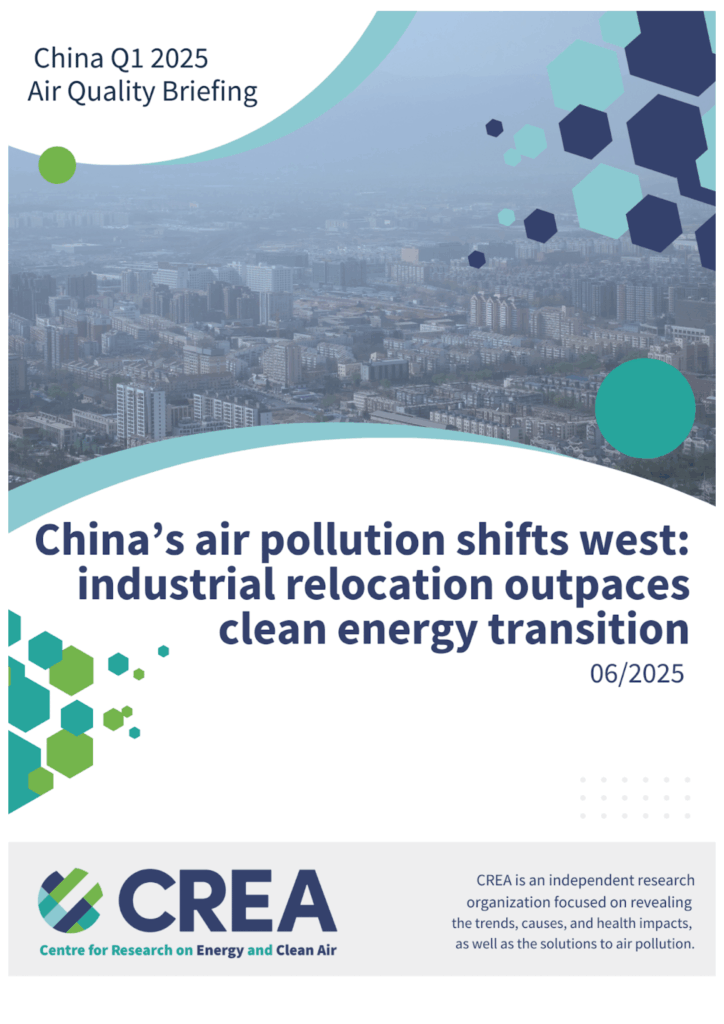A new review of China’s air quality by the Centre for Research on Energy and Clean Air found that China made notable progress in air pollution control in the first quarter of 2025. The national average concentration of PM2.5 declined by 5% year-on-year, and other major pollutants closely linked to industrial activity and fossil fuel combustion—such as SO₂, NO₂, and PM10—also showed overall declines or remained stable.
However, behind the overall improvement lie persistent challenges. PM2.5 levels nationwide still exceeded the national air quality standard by 18%, and nearly three-quarters of provincial-level regions failed to meet compliance targets—indicating that winter remains a season of acute health risk due to particulate pollution. At the same time, ozone pollution followed an opposite trend, increasing by 4% year-on-year, and is now emerging as the major counterpressure in China’s air quality governance, reinforcing a dual challenge of winter PM2.5 and summer ozone.
Key Findings
- Pollution pressure is shifting towards western areas that are not prioritised in air pollution control policies. In Q1 2025, although average PM2.5 levels in China declined by 5%, provinces such as Guangxi, Yunnan, and Xinjiang saw significant increases of 32%, 14%, and 8%, respectively. Notably, these rises were not driven primarily by weather, but by structural emission growth. This shift reflects both the westward relocation of industrial activity and the influence of non-industrial sources like sandstorms and biomass burning. It signals growing air quality risks in non-priority areas, including ones traditionally regarded as clean-air strongholds.
- Western provinces saw the most pronounced increases in energy-intensive production, with pig iron (+10.5%), crude steel (+5.8%), and non-ferrous metals (+4.2%) all rising notably—highlighting a clear shift of heavy industrial capacity westward. This expansion remains tied to coal-heavy steelmaking and conventional coal chemical processes, offsetting gains from cleaner power structure.
- Heavy pollution episodes are rebounding in inland regions. While the national average percentage of heavily polluted days decreased, northwestern and central Yangtze River provinces such as Ningxia, Shanxi, and Hubei experienced localized increases. These areas showed concurrent rises in both heavily polluted days and de-weathered PM2.5 concentrations, pointing to persistent structural emission sources rather than meteorological anomalies.
- Western and central non-key regions should be integrated into the core of air quality management as industrial activity expands westward. Looking ahead to the 15th Five-Year Plan, China has the opportunity to embed stronger air quality controls into its broader industrial transformation agenda, positioning air quality as a key metric of regional resilience and competitiveness. Key priorities include accelerating clean energy deployment and enhancing regional decarbonisation coordination to prevent pollution from shifting into previously low-pollution areas.

To respond to the shifting geography of pollution, China’s air quality governance should evolve from a focus on eastern “key control zones” toward a nationally coordinated, regionally responsive system that supports equitable and sustainable development.
First, future policy frameworks, especially under the upcoming 15th Five-Year Plan, should formally include western and central provinces in core air quality governance. This includes allocating dedicated targets, funding, and oversight capacity to these regions, where industrial expansion is accelerating. Strengthening environmental impact assessments for new investments, linking them to land-use planning and energy access, can help prevent cumulative pollution risks at the source.
Second, energy transition efforts should prioritize clean power infrastructure and industrial electrification in coal-dependent provinces. Support measures such as fiscal incentives, power grid investment, and public-private partnerships can accelerate the replacement of outdated processes in key sectors like steel, coal chemicals, and non-ferrous metals. Eastern provinces should be encouraged to support these efforts through technical cooperation, investment flows, and joint pollution reduction targets.
Finally, air quality management should be more directly aligned with regional development strategies. Integrating air quality into local talent, health, and urban competitiveness indicators will help ensure that cleaner air translates into tangible benefits for residents. Establishing national guidance on air quality-linked performance assessments can incentivize local governments to prioritize long-term public well-being alongside economic growth.
